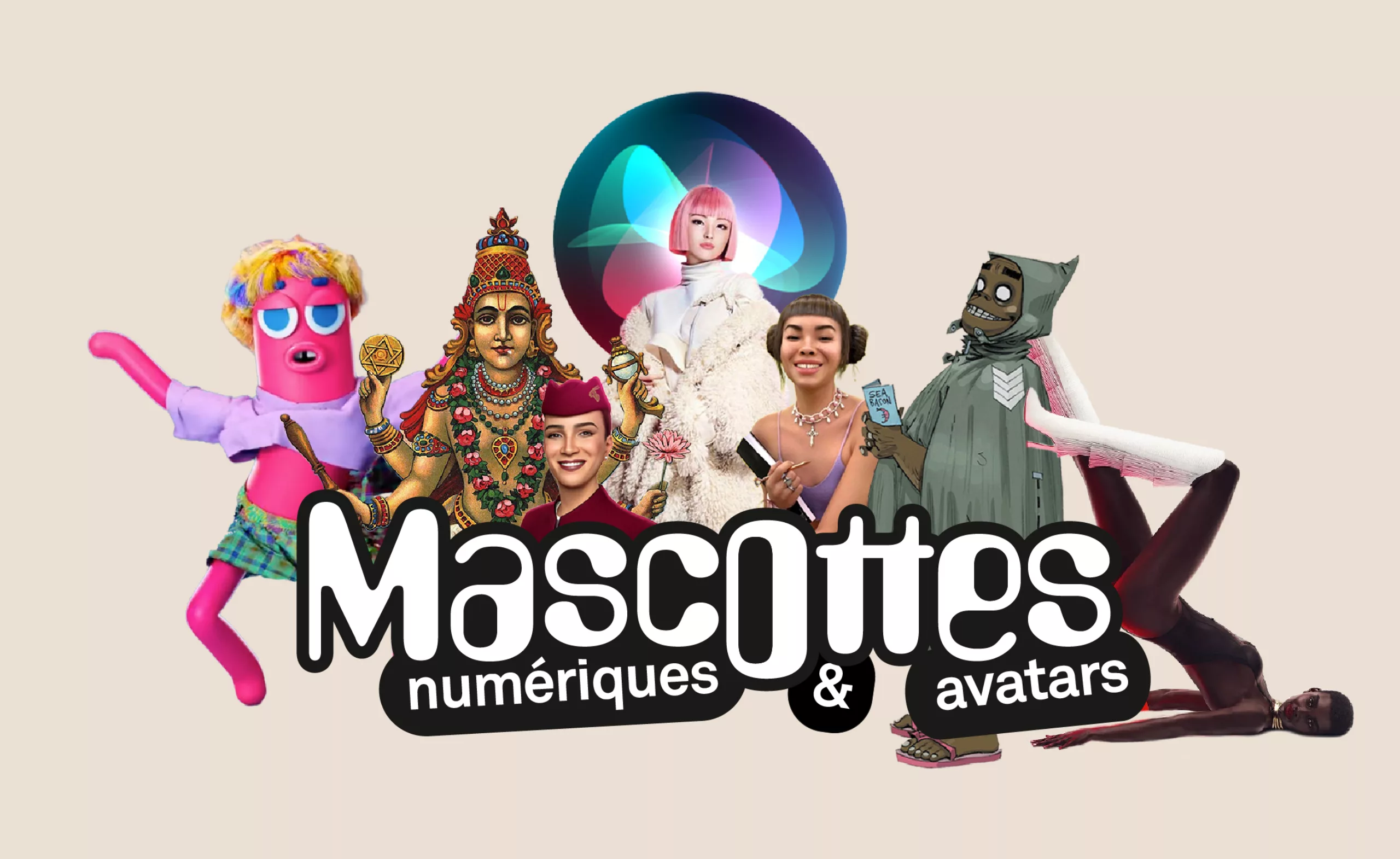Cannabis branding: a green history
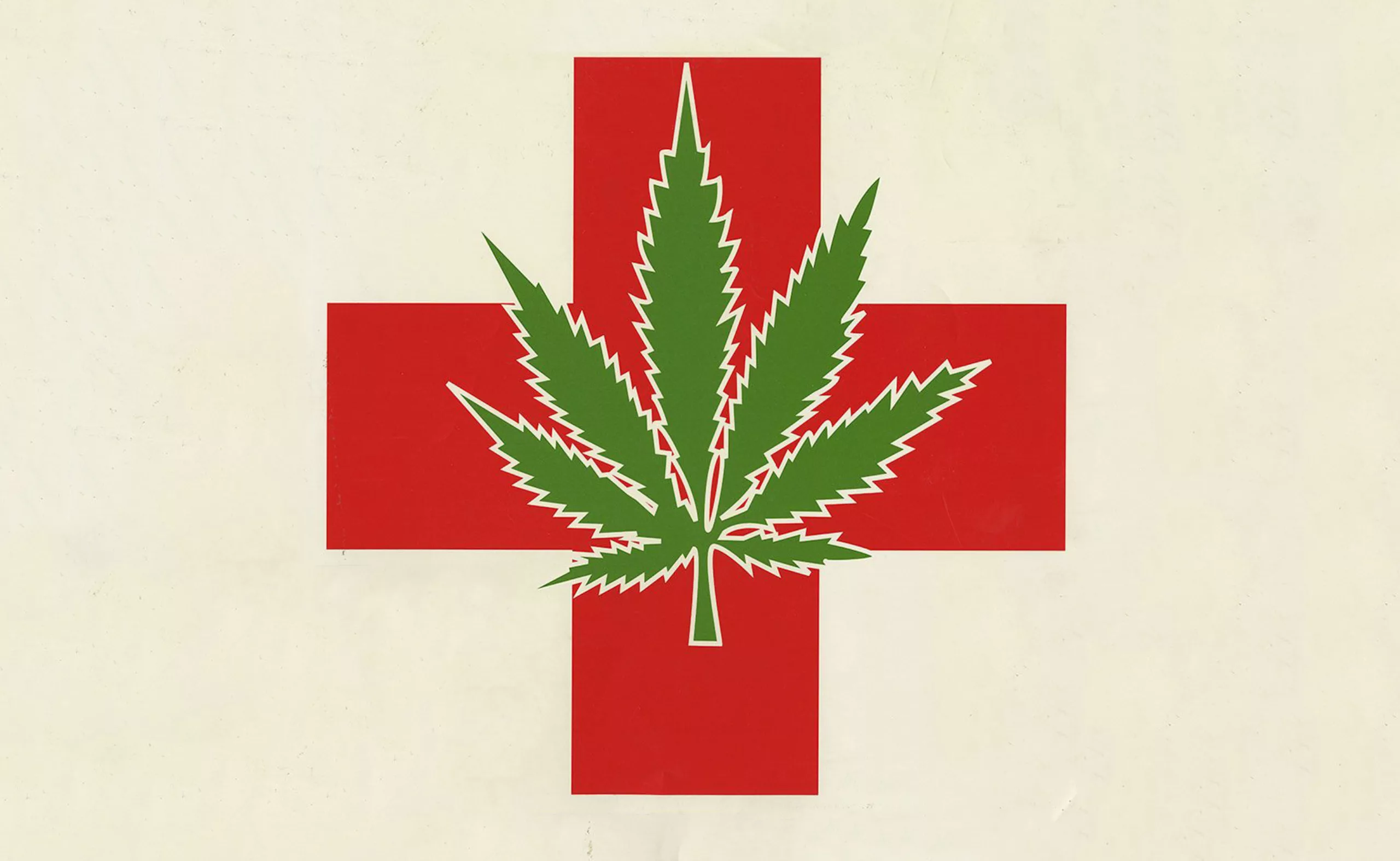
Since last June, we have seen light coffeeshops blooming all over France. Paris, Bordeaux, Lyon… some already had to close their doors, but the craze is there. Following in the footsteps of pioneering Uruguay, followed by the United States and many European countries, Canada will be the next country on the list to legalize cannabis in October 2018.
Cannabis: from stoned to superfood
In these countries, the legalization of cannabis is leading to a new business, which is no longer focused solely on its psychoactive properties. With the emphasis on the superpowers found in this medicinal plant, cannabis is gradually freeing itself from the codes of the kingdom of high. While the seven-pointed leaf has long rhymed with peace & love and displayed the green-yellow-red colours of the Rastafarian flag, the new companies are turning it back to a therapeutic emblem. And who talks about trade also has to tackle branding and packaging.
So how do these new companies get away from the image of “illegal drugs” and move on to that of “miracle plants” image? Hashish and its derivatives dealers and shops seem to be pioneers in their field and can invent new codes for this versatile plant. But before getting to the heart of the matter, let us take you on a journey into the wonderful history of cannabis!
Hemp or cannabis, let’s not confuse herbs!
In order to clear up any suspicion, let’s start with a little scientific interlude. Nowadays, cannabis is best known for its psychotropic effects, which make it a plant defamed and persecuted by governments, yet it has enjoyed centuries of glory in many civilizations. If cannabis means hemp in Latin, one crucial thing differentiates the two terms. The two related plants have some genes that differ, and are not to be confused. Both produce a significant amount of cannabinoids, the best known of which are tetrahydrocannabinol (THC), a powerful psychotropic, and cannabidiol (CBD) with medicinal properties. It should be added that our body naturally produces cannabinoid receptors, neurotransmitters called anandamide that come into contact and react when taking CBD or THC.
As Jamy explains in the video below, cannabis produces psychoactive resin in quantity (THC, therefore) while hemp has a low THC content but is very rich in CBD. No risk then, to get high on hemp! It is the derivatives of these plants that are generally legalized and sold as food supplements or medicines, as in the United States.
As the Hash Museum in Amsterdam points out, “although cannabis is one of the safest and least toxic recreational substances known to man, its abuse must be avoided as with any substance. However, while cannabis is much less likely to cause harmful effects than, for example, alcohol, its recreational use remains one of the most defamatory, misunderstood and misinterpreted aspects of cannabis in the media.”
Hemp has the advantage of being a herb that has been growing wild for centuries and does not require pesticides or water to grow. The fact that it has remained wild for centuries makes it a resistant and adaptable plant for almost everything. It seems to be the perfect way to save the world since it cleanses soils from heavy metals (it currently purifies Fukishima’s soils), and can be transformed into biofuel, paper, cosmetics or medicine, insulation, mulching… in short, almost everything. As a textile, it also requires 3x less water than cotton and its fibres are much stronger and insulating, and can be waterproof.
So it’s a very good “weed” in a way, which deserves to make a acclaimed comeback. Our ancestors understood this well!
If you want to skip the historical part that will make you an expert on cannabis, you can go directly to the branding section (but you will miss some stunning anecdotes and beautiful images).
The hazy origins of cannabis
Grown for 12,000 years, since the end of the first ice age (prehistoric times), cannabis sativa – or hemp – is one of the first plants domesticated by man! It has valiantly passed through the ages as an adulated, revered or hated, before making a shy but promising comeback today.
The grass people
Cannabis was cultivated first for its fibres from its stems, from which cloth or paper was made, then for its seeds with high nutritional value, hempseed, and later for the medicinal and psychotropic properties of its resin. For lack of evidence, it is not safe for Mesolithic men to have used it to “open their minds” before their rock painting sessions. But it is more likely that they used it to heal themselves than to delirium on the walls… the mystery will remain intact.
The geographical origin of this plant also remains uncertain. It seems that it is nevertheless native to Central Asia, in a region stretching from southern Russia, Mongolia, China and as far as northern India, around the Himalayas. What is certain is that archaeological excavations in China have revealed pottery marked with hemp ropes or an entire plan of marijuana in a 2,700-year-old shaman’s grave (which was not a Chinese one), evidence of the plant’s multiple uses.
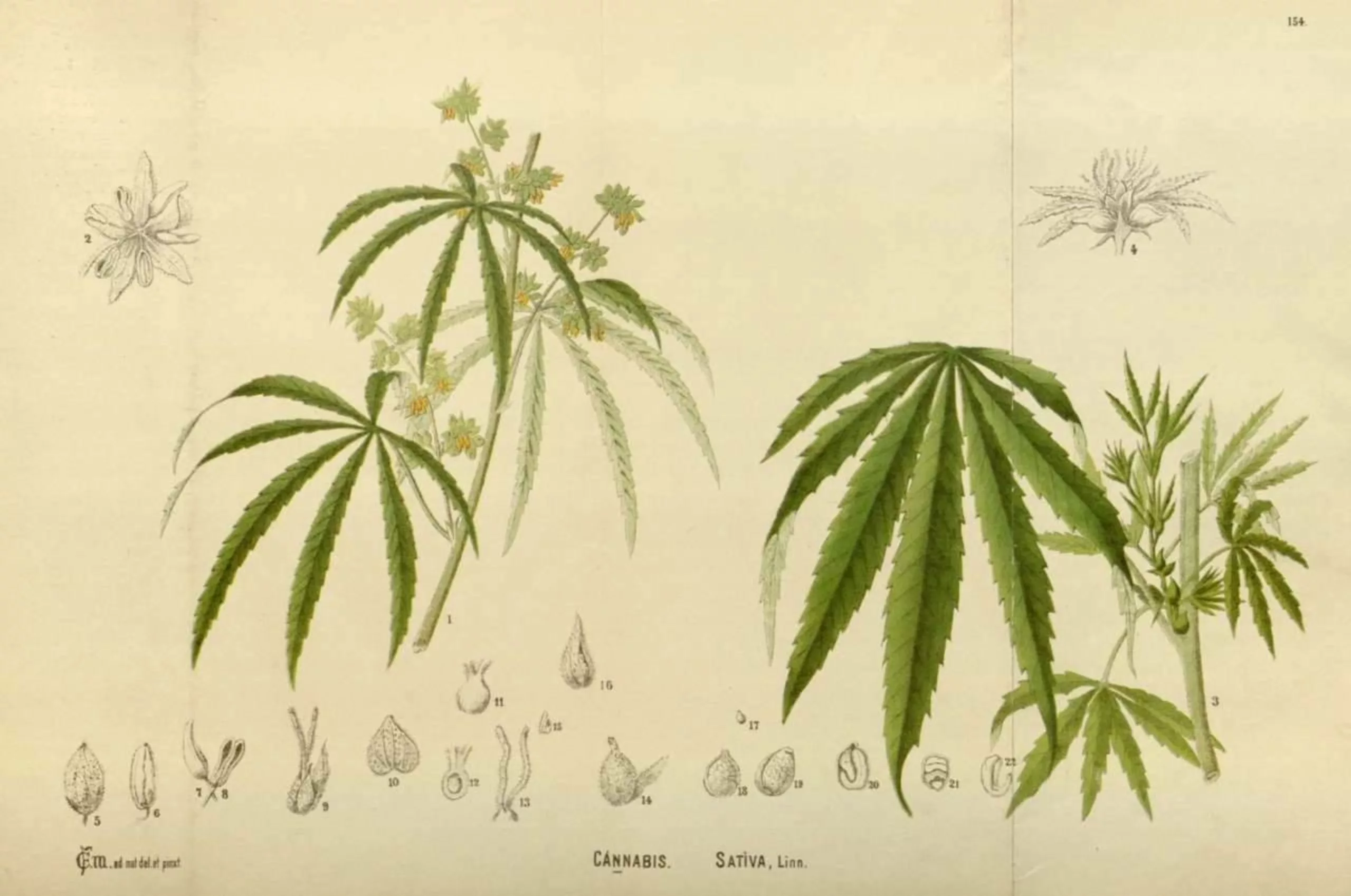
Travelling on horseback with the Eurasian peoples going on to conquer the world, cannabis arrived in the Middle East (more precisely in Egypt), to reach Germany (the famous Hildegard of Bingen cultivated it in her garden and recommended its therapeutic use) and Greece, and later England. It reached the Caribbean by boat with Christopher Columbus in 1492, which will be discussed below.
The 14th century saw the appearance of the first text to prohibit its use in the Ottoman Empire. France, on the other hand, experienced a wave of hashish when Napoleon’s troops returned from Egypt in 1801! Hemp had already been introduced by Muslims in the 12th century. After an assassination attempt by a man under his influence, Napoleon had the consumption of hashish banned in Egypt: “the use of strong liquor made by a few Muslims with a certain strong herb, called hashish, as well as that of smoking hemp seed, are prohibited throughout Egypt. Those who are accustomed to drinking this liquor and smoking this seed lose their minds and fall into a violent delirium that often leads them to commit excesses of all kinds.” Napoleon later banned its use in France, becoming the precursor of the anti-drug fight.
As for hemp, it enjoyed its heyday in France in the 19th century (as seen on these postcards) before almost disappearing in the 1960s with the arrival of petrochemicals, which advanced its synthetic fibres like nylon, to the detriment of hemp. Today, our country remains the leading producer of hemp in Europe with more than half of the land area (cock-a-doodle-doo!).

The thousand uses of the magic plant: conquering the world
Hemp had therefore been used for several centuries in many civilizations. We find its trace in these ancient cultures, in various forms, which we describe here by country.
It was common for many of these peoples to inhale the smoke from cannabis seeds burned during religious ceremonies, such as the Scythians who organized collective fumigation sessions in tents, or to use the plant for its medicinal properties.
For example, traces of seeds and resin have been found in Egyptian sarcophagi. Also in Egypt, the goddess of writing Seshat was represented with a cannabis leaf above her head, to “open the door of the spirit” (see engraving below). Moreover, we can read on the Ebers papyrus several medicinal remedies made from hemp and its seeds, along with other ingredients such as mouse tails, cat hair, goose entrails…. This document is an Egyptian pharmacopoeia with more than 700 remedies and is one of the first documents to mention cancer.
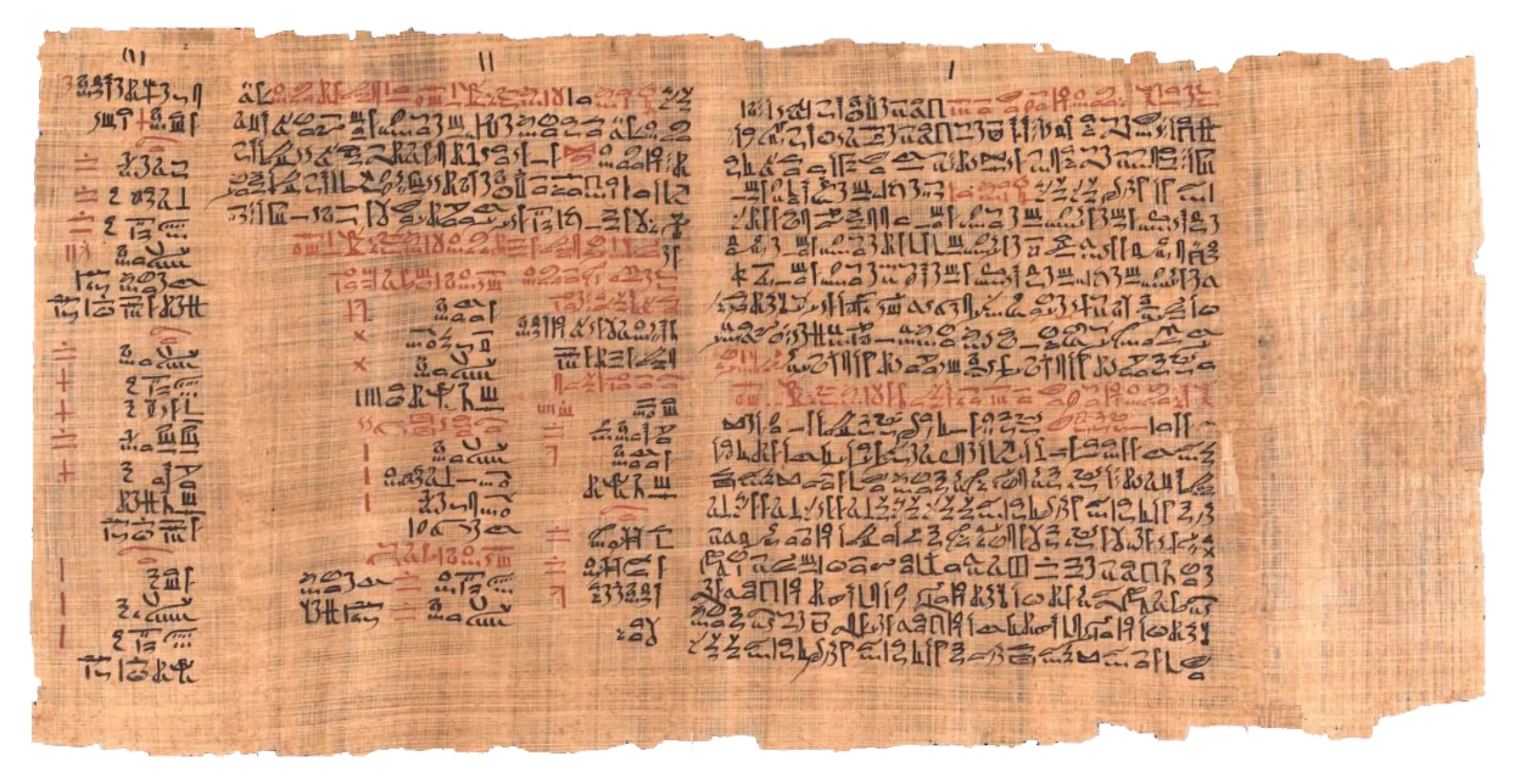
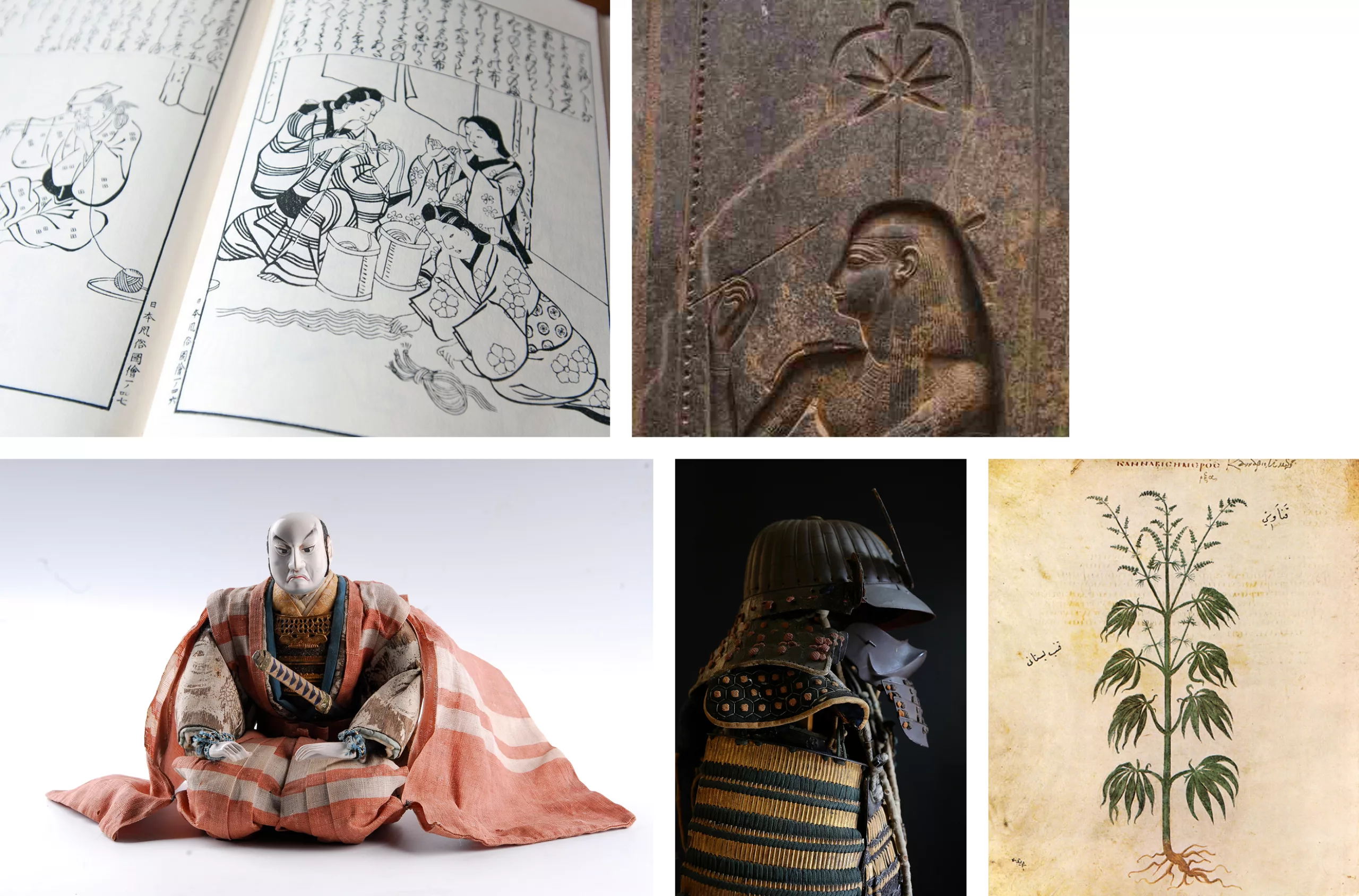
In Japan, hemp was also a luxury material, and samurai used its woven fibre to make waterproof clothing, soaked in khaki juice (see pictures above). In the 14th century, the daimyo warlords encouraged their vassals to cultivate hemp (see this 17th century print, photo Hiroko Tanaka and Junichi Takayasu), and the emperors draped themselves in it. After the Second World War in 1948, under the influence of the United States and its anti-drug lobbies, Japan passed a law criminalizing cannabis possession.
In 1492, far from getting high during the crossing, our dear Columbus owes his discovery of the Caribbean to hemp, of which he had a thousand uses. On period boats, hemp was used to make ropes, weave strong sails, feed people with the seeds stored in the flagpoles, waterproof the soil with leaves slipped between the battens, take notes on hemp paper or even light up with its oil. Moreover, the monument to Columbus in Barcelona is decorated with hemp leaves… what else (photo on the left)?
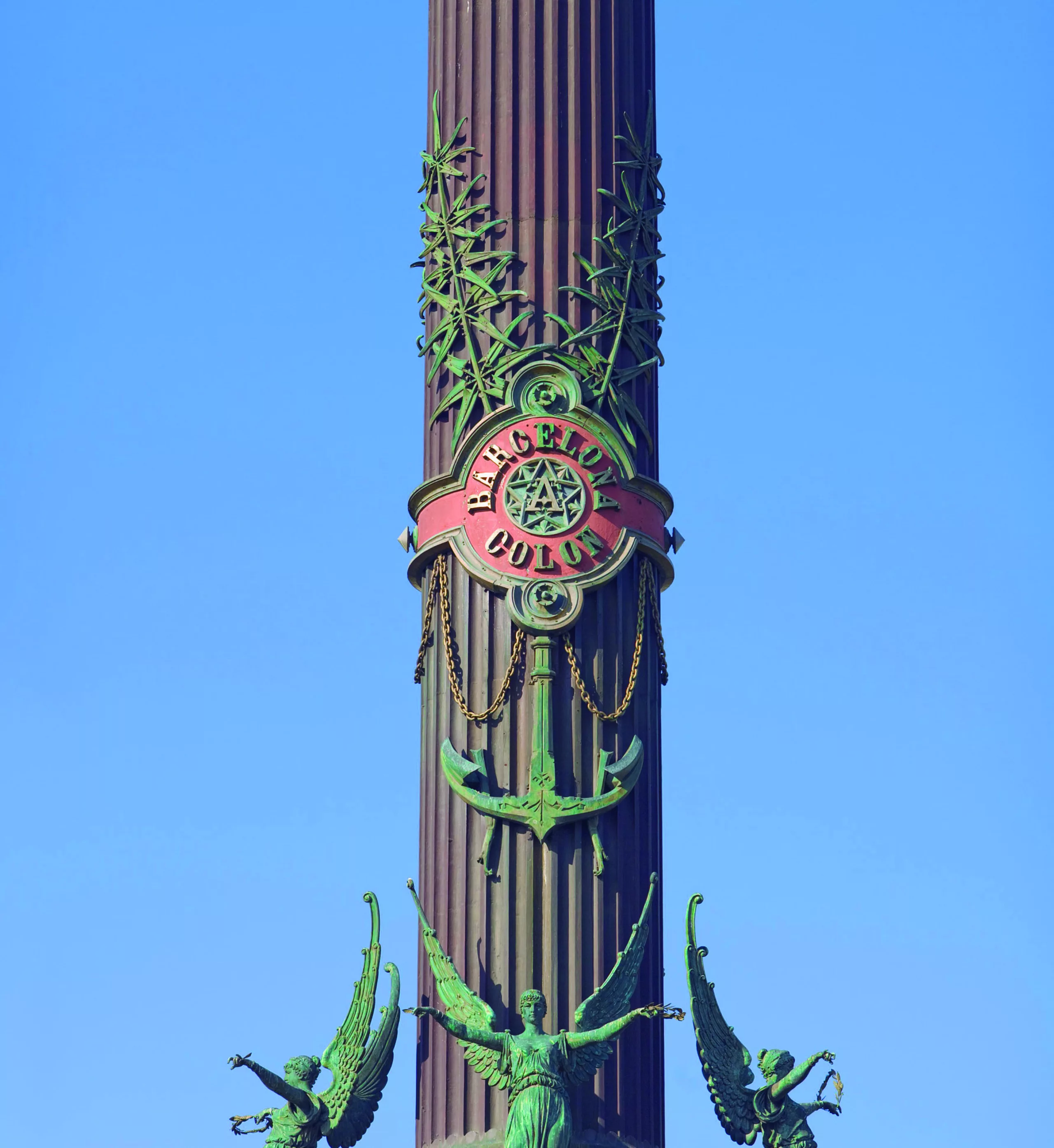
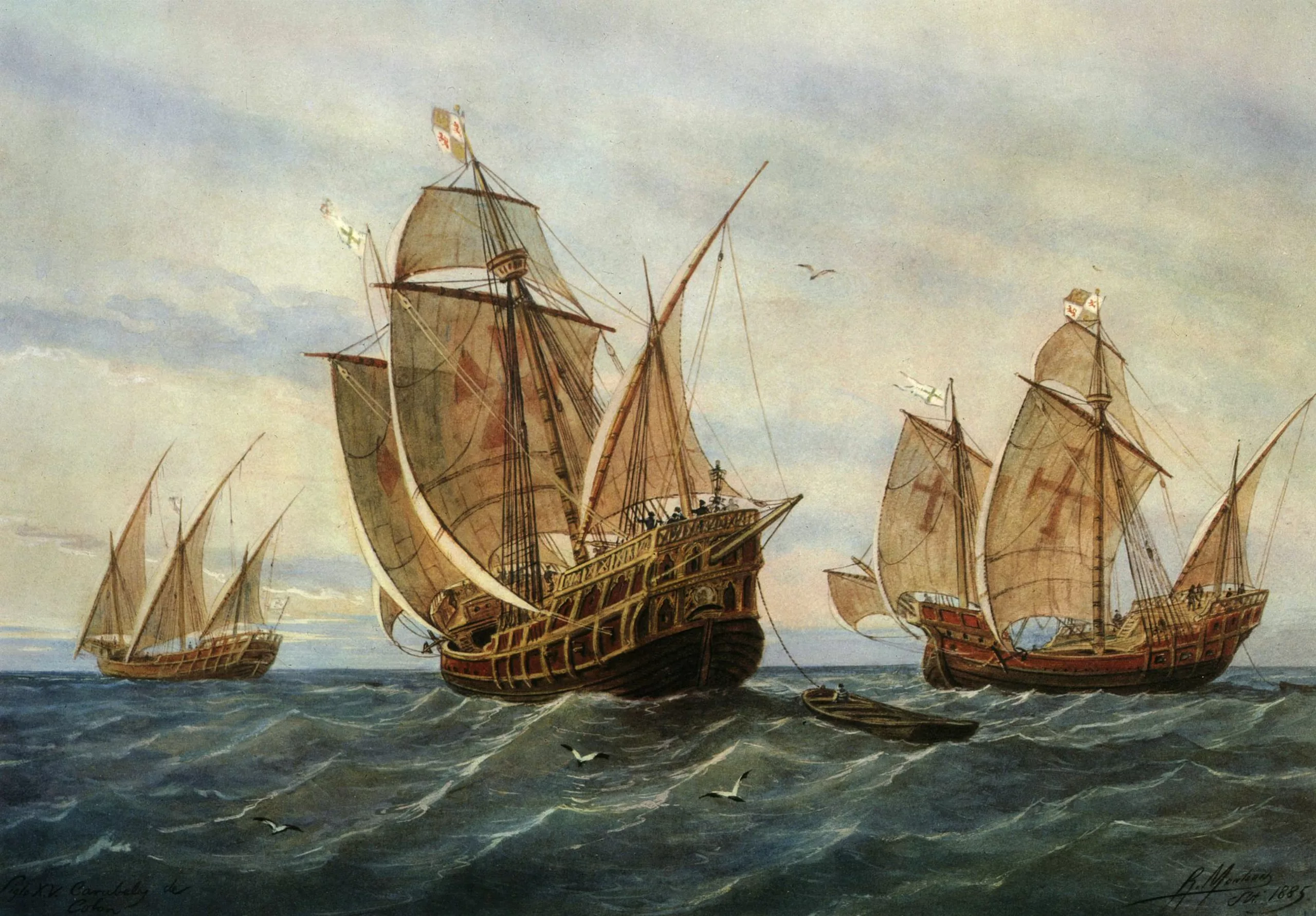
The Russians, for their part, were the first hemp exporters in the 18th century. In other words, given the way it was used at the time, Europe is at their feet. Napoleon (decidedly) tried to weaken the English who depended on the Russians by making them sign a peace treaty in 1812. On one condition: that Russia stop trading hemp with England! The more hemp, the more boats. No more boats, no more army… Not crazy wasp. Luckily, the Russians broke the treaty a few years later. To get revenge, Napoleon invaded Moscow, and broke his teeth. We’ll hear less about him afterwards.
Healing cannabis, a soft drug
In China, around 1500 BC, hemp was already cultivated for its nutritional virtues and fibres. Bows were made with its rods, revolutionizing archery and armament. But the first references to cannabis as a medicinal plant, which, according to legends, date back to 2800 BC, are mainly due to China, since it appears in the herb encyclopedia of the mythical emperor Shennong, father of Chinese medicine. Shennong bencao jing, unfortunately disappeared, mentions a plant capable of lightening the body and prolonging life. Even today, its symbol Má 麻 representing leaves in a dryer is used in China in words such as anaesthesia (mazui 麻醉) or numbness (mamu 麻木).
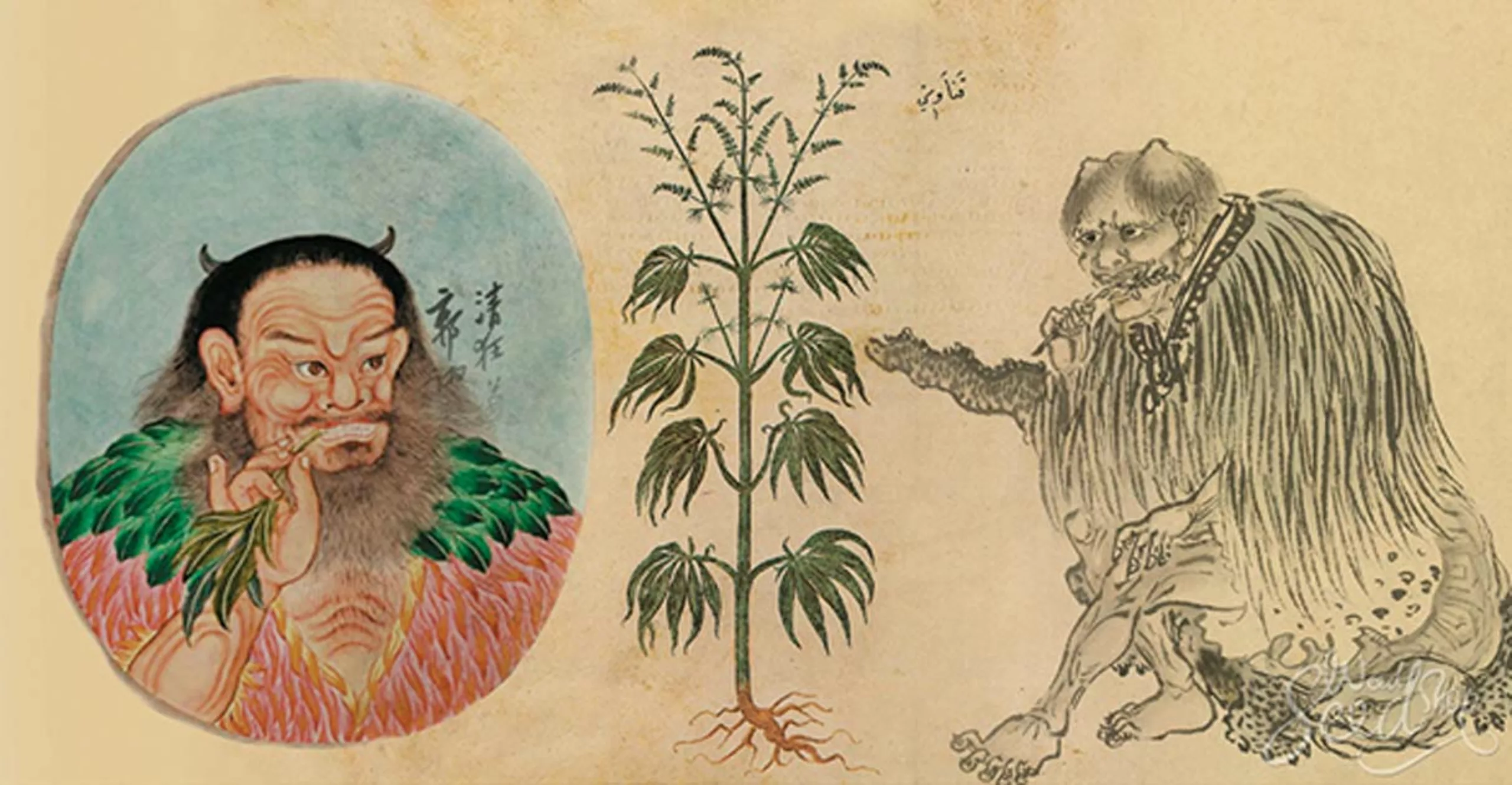
It was not until 1839, however, that hemp was introduced as a medicine in Europe by the Irish medical doctor William Brooke O’Shaughnessy. At the time, it was used in cannabis tinctures, infused in alcohol with green tones. Cannabis quickly became the second most widely used ingredient in pharmacies in the United States and Europe until the early 20th century! It was used to fight cramps, hysteria, pain and corns in the feet. The invention of aspirin marked the end of the use of the “green dragon”.
In terms of branding, no sign of cannabis leaf on the horizon. The vials and cans are the same as those of any other remedy. It must be said that the Rastafari culture does not yet exist… We will discuss this further below in the religion section.

Carl Sagan, an astronomer and essayist / active marijuana user, hypothesizes that in these civilizations, the cultivation of hemp led to the invention of agriculture, and thus the birth of civilizations. On a global scale, the peoples who have taken advantage of hemp owe it a global influence. So where does all this controversy and fear of cannabis come from?
Vade retro cannabis
In the late 1920s in the United States, cannabis was thought to have supernatural powers… but it was defamed for its psychotropic qualities and was soon banned by prohibition. So we used code names to talk about it, and one of his nicknames was “spinach”. We invite you to listen to Julia Lee’s The Spinach Song: “I used to run away from the stuff, but now somehow I can’t get enough. I didn’t like it the first time, oh, how it grew on me!”
Moreover, since its creation in 1929, Popeye the sailor man, a great traveller who knew the plants of the world well, regularly consumed spinach. Or was it something else in his pipe? However, in the midst of a prohibition, the government is using a spinach/grass consumer to raise awareness among young people. Nice job.
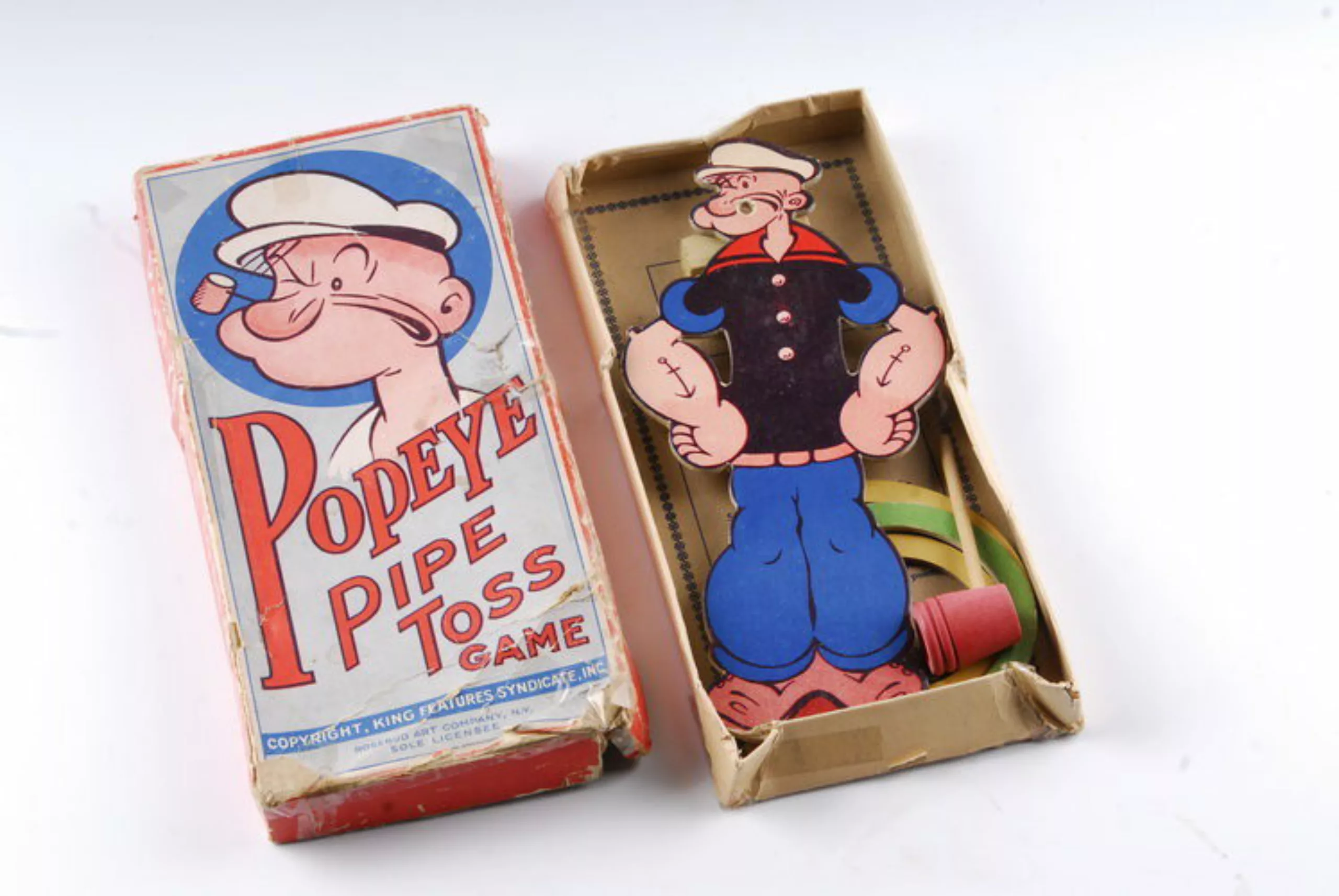
The use of cannabis was finally banned in 1937 in the USA. Of course, it was not only used as a drug and puritanical anti-cannabis lobbies were starting government-backed propaganda to denounce this green demon, this “ticket to psychiatric asylum” said to destroy youth. Synthetic fibres and drugs needed a springboard, and their biggest competitor first had to be destroyed.
It is this fierce fight against cannabis and this image of a murderous plant that crossed the Atlantic and got into people’s minds, and is still very well established today. Of course, this plant remains a drug with all associated vices, but we are sure that without this lobbies attack in the 1930s it would surely cause much less controversy among the general public, and its medicinal or textile values would be much more valued, for the benefit of all.
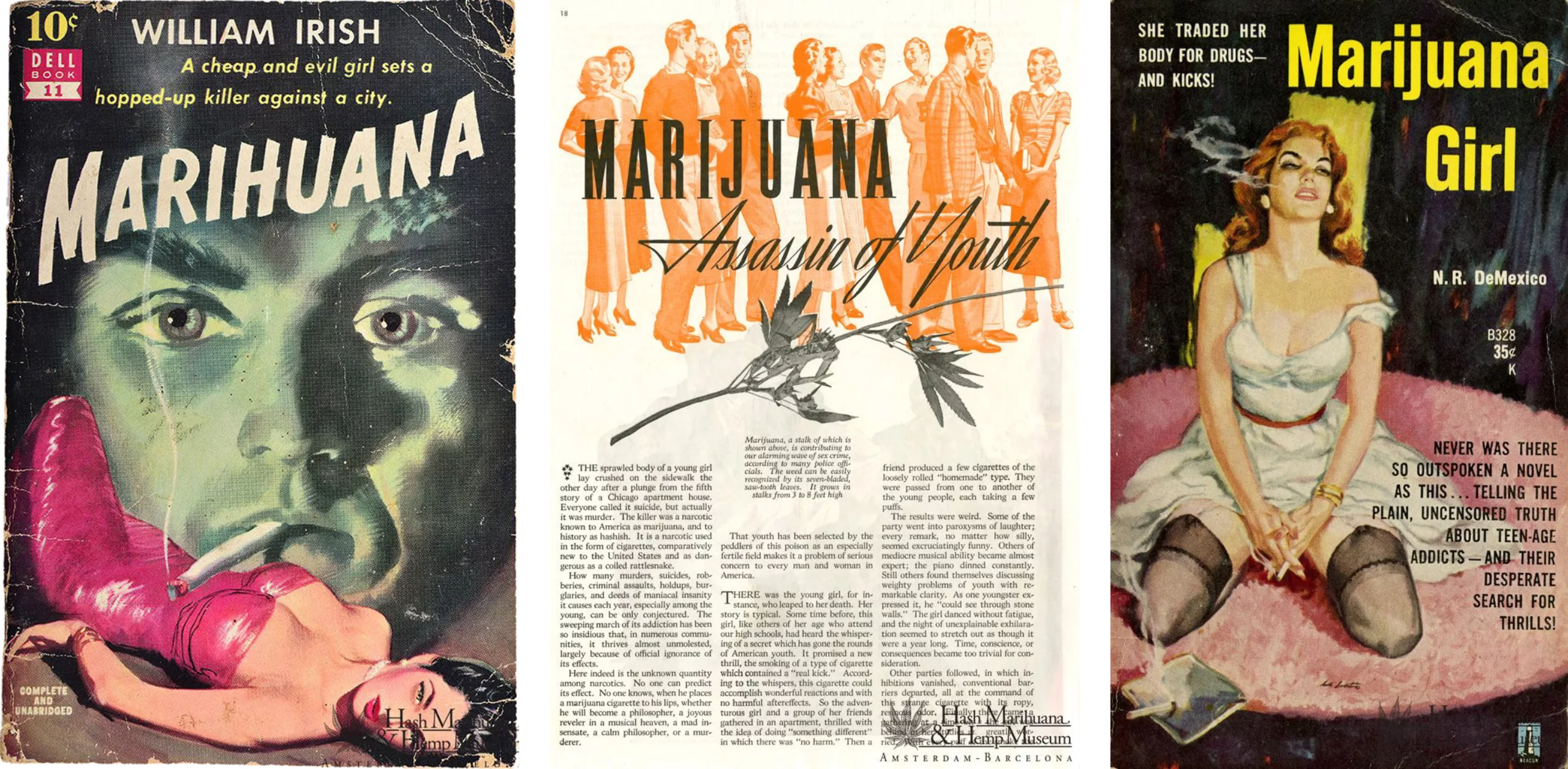
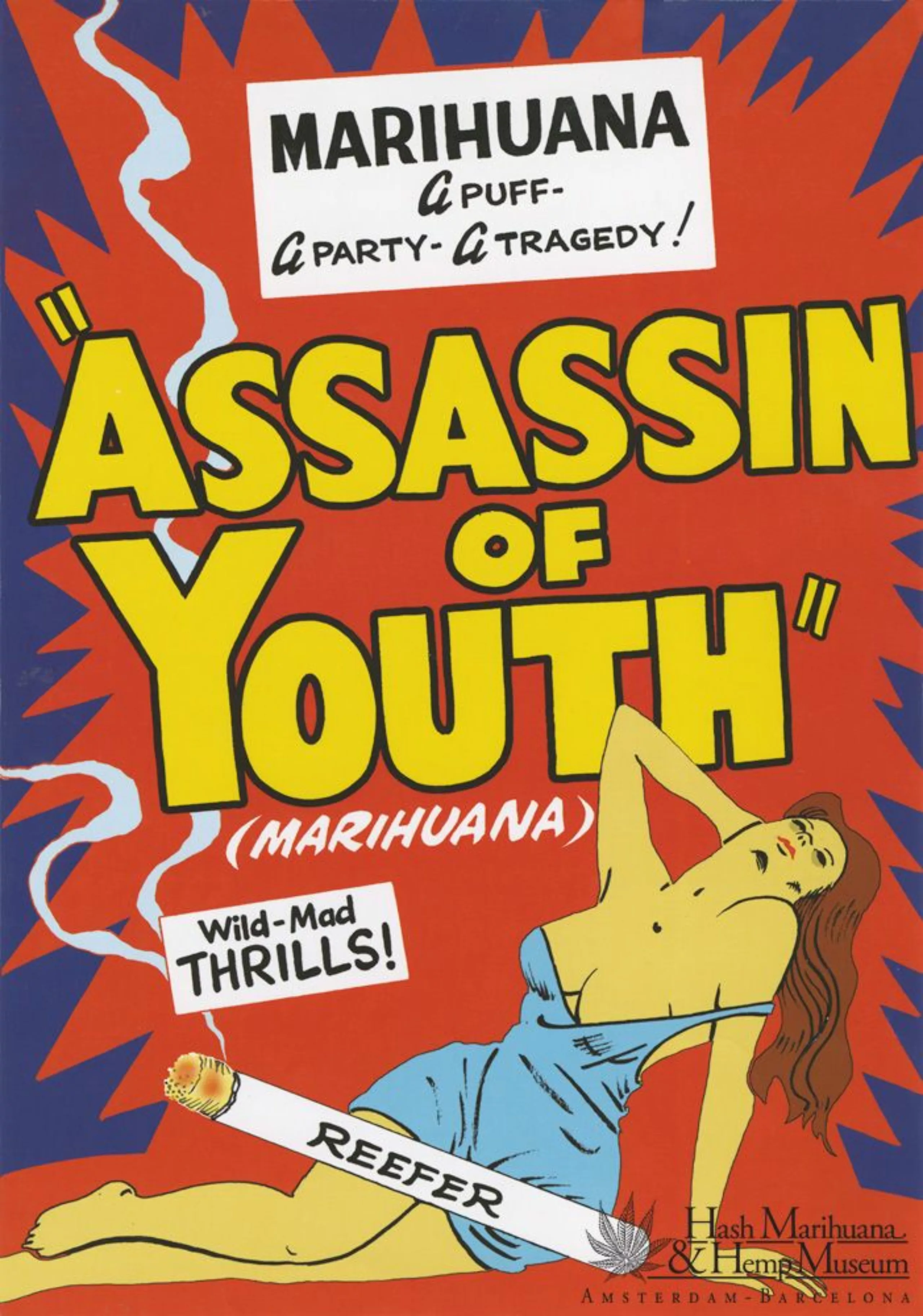
PS: If you like book covers, you can discover our series of 4 articles ranging from treasure books to the first color illustrations, including the invention of the pocket size, the figure of the woman on American paperbacks (like those shown here) and the specificity of the covers of major French publishing houses.
Blessed be the cannabis
There has been talk of the thousand uses of cannabis, not to mention its role in many religions. The sacred plant has performed miracles and converted crowds, probably because of its combined psychotropic and curative effects. Because it’s funny, even if it’s a little off topic (but not completely, you’ll see) we’ll take a little look at religions and cannabis.
There are traces of cannabis in Shintoism, Buddhism, Taoism, Sufism, Rastafarianism of course, but also Islam, Catholicism and Judaism, not to mention Shamanism… one wonders why!
In India, cannabis is linked to the cult of the God Shiva, to whom burnt grass is offered. Shiva is said to have created cannabis from her own body to purify the elixir of life. It is also said that Buddha survived by eating one hemp seed a day.
On the Bible side, there are several references to the use of kaneh bosem, an aromatic stem – derived from the word cannabis – as a medicinal plant sometimes used by Jesus as an ointment applied to the heads of the sick. This is evidenced by this mosaic of a Sicilian cathedral, in which Christ cures two blind men under a cannabis leaf. Herbs and incense were also thrown into the fire during masses; it must have been fun at the time.

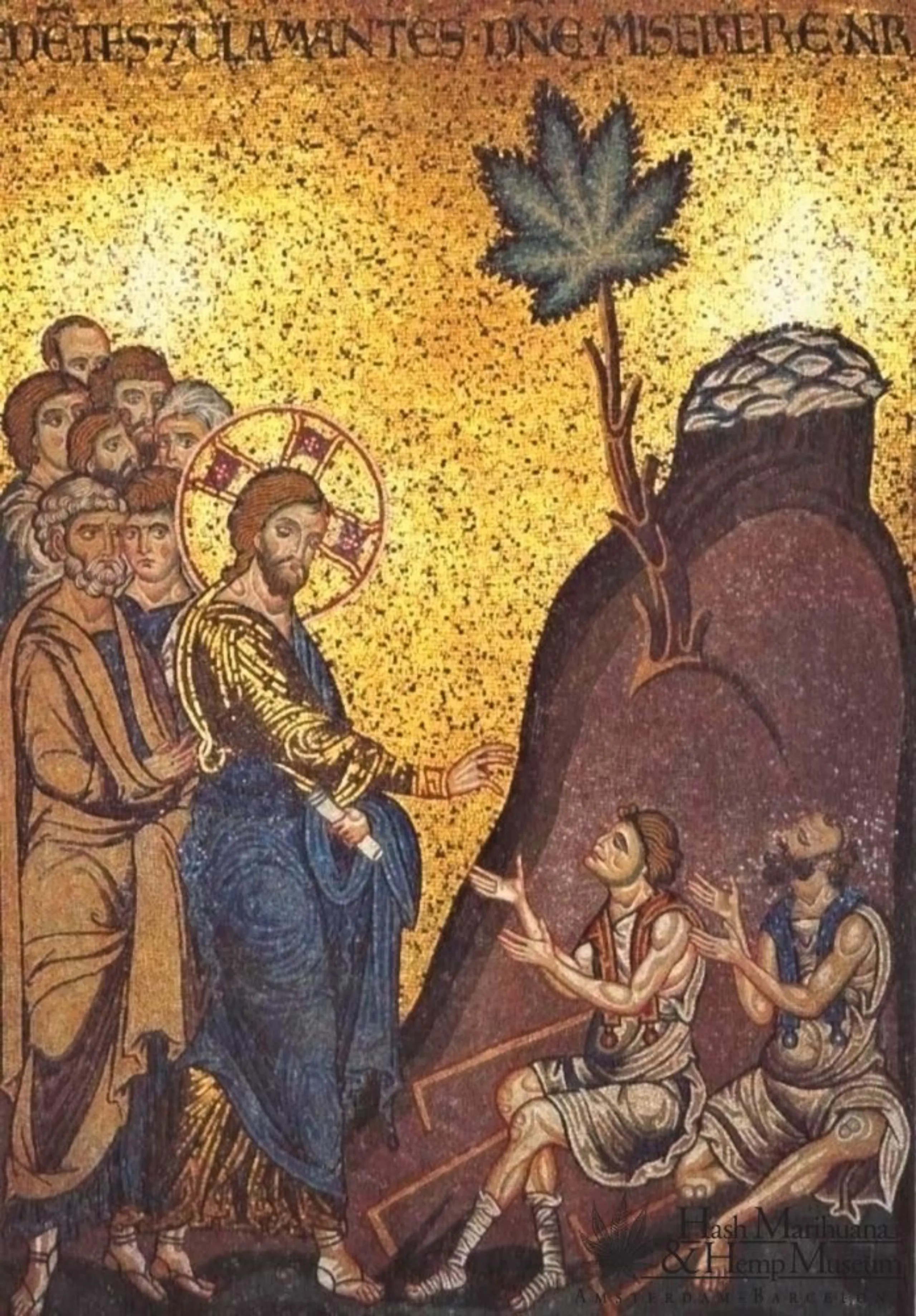
Among the Rastas, marijuana is emancipatory
Well, of course, whoever says cannabis and religion thinks: Rastafari. This is where we come back to our sheep. 80 years of Rastafarian philosophy have drastically influenced the image of cannabis, and somehow its image. Rasta is one of the only survivors of legal cannabis cultivation (not to mention Sâdhus or other Hindu cults). Obviously, in a world where its use has been prohibited everywhere, the colours green yellow red strike to the point of becoming a symbol intimately associated with the plant.

The Rastafari movement was born in 1930 in Jamaica with the coronation of Haile Selassie in Ethiopia. Prophet in spite of himself, announced by Marcus Garvey as “crowned black king in Africa”, he is a sign of the beginning of emancipation from the white oppression. His king’s name is Ras Tafarí Makonnen, from whom the Rastafari cult derives. Jamaica, at the time, wasn’t a party land. Since May 3, 1494, when Christopher Columbus discovered this new land, Jamaica has been colonized by the Spanish, its people enslaved and its lands exploited. When there is a shortage of labour, slaves from African countries are brought in en masse. Then the British pirates settled in and finally gave way to an empire of planters and slaves, under the English crown. The island gained its independence in 1940, after more than 500 years of alienation, while retaining its status as a member of the Commonwealth.
All this to explain the context of resentment against “Babylon”, the white empire, and the desire to emancipate oneself. The very title “religion” does not suit Rastafarians, who do not like labels, derived from the Babylon system. More generally, they believe it is wrong to worship profit-oriented institutions. Any Rastafarian who respects himself above all respects Nature: unprocessed food, no or little meat, and hair that is allowed to grow like a sacred fleece. Some people choose not to smoke marijuana to maintain their integrity! Cannabis is exclusively consumed during religious rites, to enter into trance and communion with Jah (God, Jehovah’s contraction), and the universe. In any case, consuming this herb outside religious ceremonies is frowned upon by the Rastafari community. It also suffers from this image of a stoned kingdom, wrongly attributed.
Banning and prohibiting the use of this “plant of wisdom” or “sacred herb” is an example of Babylon’s immoral sense of seeking to control nature, which no one should possess. For Rastafarians, smoking cannabis, this good wild weed and gift of nature is also a way to resist the system of thought. The only problem is that the plant is not endemic to Jamaica, since Christopher Columbus brought it back during his travels! Big scoop, it’s not written anywhere and I had a brainwave when I wrote this article: the Rastafari cult is therefore based on a plant… imported by Babylon! Strangely enough, everyone remembers that Columbus brought death, but no one remembers his importation of ganja.
Once revered and used in all its forms, then cornered and banned in almost all peoples, cannabis now seems to be gradually reborn from its ashes.
The branding of cannabis, between leaves and flasks
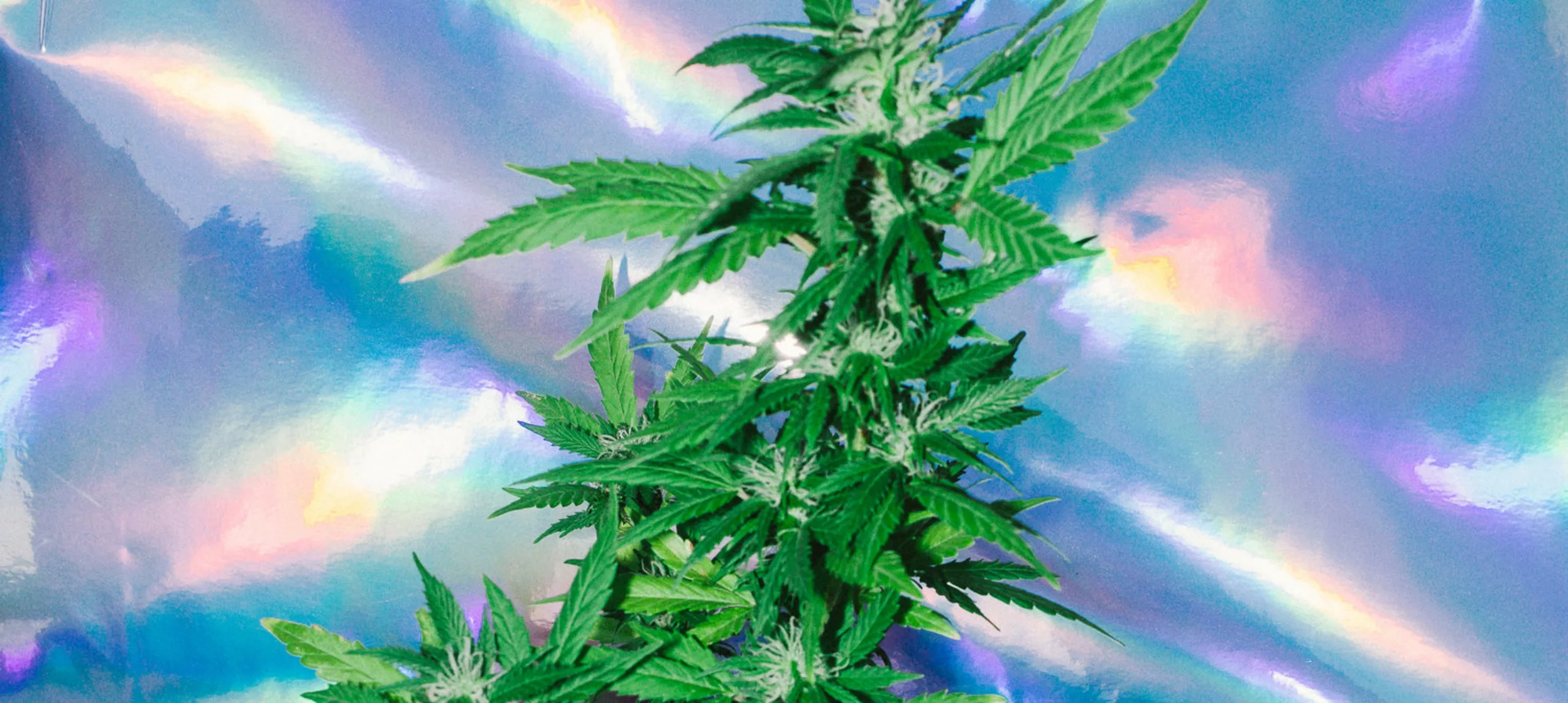
Today, with the progressive legalization of the plant in many countries, cannabis needs to be rethought. First, because it is a question of getting rid of this erroneous vision in Rastafari colours that sticks to it, and second because cannabis is no longer sold only for its narcotic properties, but also for its medicinal properties. It is all the more a question of moving from an image of an illegal drug to a serious miracle plant. Each use has its own image, but here again it is not so simple.
The graphic designers of the new world of grass have a still unexplored land before them in terms of branding, but often limited by over-framed legislation and the counter-image conveyed for 70 years by lobbies. Should the cannabis herb always appear on the packaging or in the logo? How to build a serious and medicinal brand around this type of product? With which codes should a brand of THC-containing derivatives be built?
Legislation and packaging restrictions
In terms of legislation on psychotropic products, Canada will face a whole range of signage that is very similar to that found on cigarette packages. It will feature a cannabis leaf symbol on a red background, and health warning recommendations.

In terms of functionality, also valid in the United States, the packaging must also be child-resistant (difficult to open) and not have attractive names for the kids. The species “Girl scout cookie” or “Bubblegum” are prohibited for sale.
For other products without THC, the legislation is more flexible. Products must indicate that they contain cannabis, but can quite visually be confused with traditional products: cosmetics, chocolates, massage oils…
My herbalist is high!
The branding of today’s cannabis is designed around a target but also a point of sale. Potentially, graphic designers must keep in mind that tomorrow we could find this kind of derivative products at Starbucks or on the Monoprix shelves (one day)! For the time being, the products are directly inaccessible to the general public, highlighted on the Internet or presented on well-kept shelves like a pharmacy.
Specialized retailers most often adopt a minimalist and high-end space design that is reminiscent of that of herbalists or apothecaries. Counter with multiple drawers, refined atmosphere, vials, plants at your disposal to smell them… We are clearly in a space reserved for the same consumers as those in urban cafés, minus the tattooed baristas.
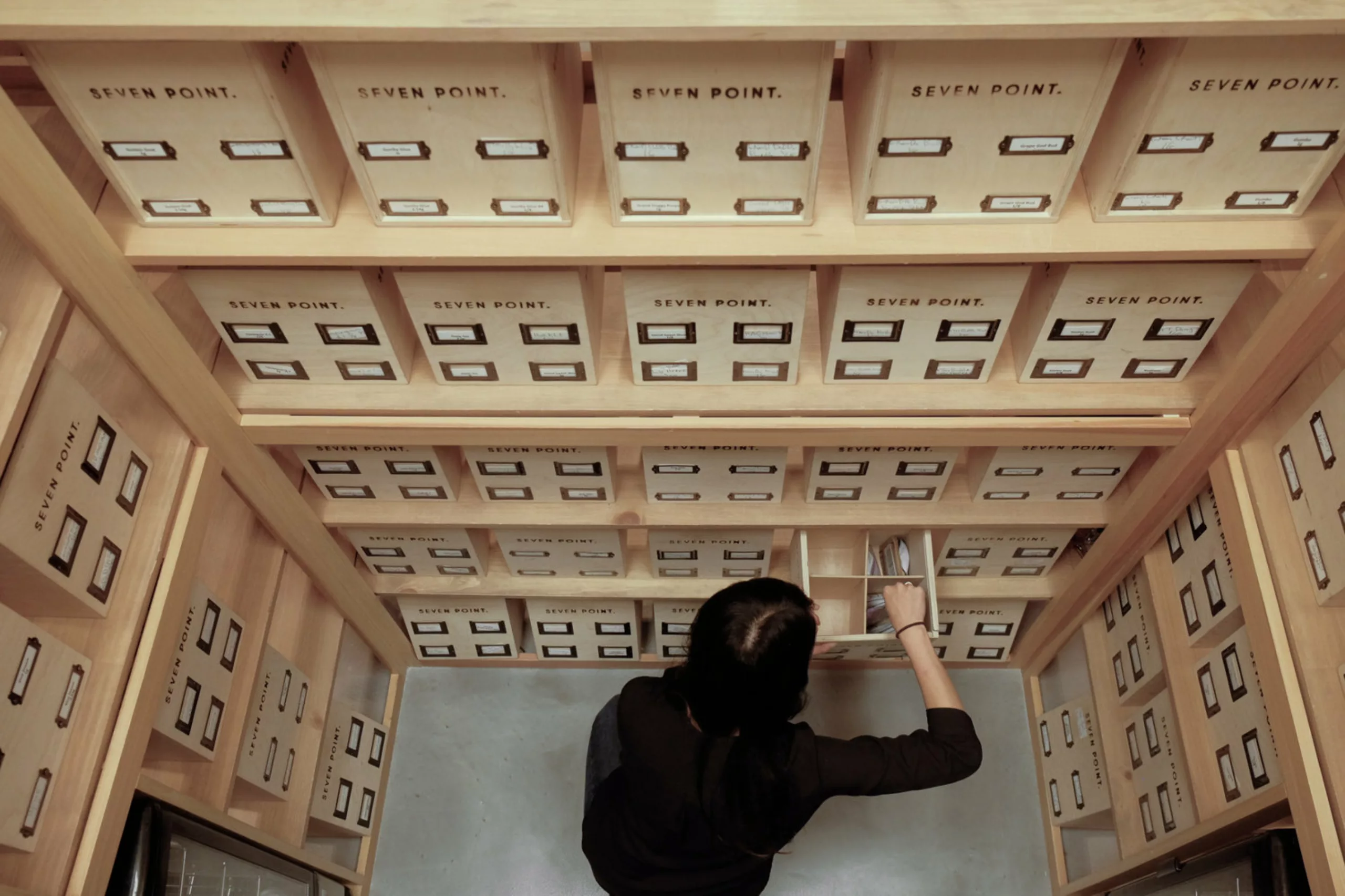
Each product has its own style
By analyzing the various existing brands of products containing CBD or THC, we identified several brand positioning options. In the marijuana family I would like….
May we introduce you?
1 – Apothecaries’ cannabis
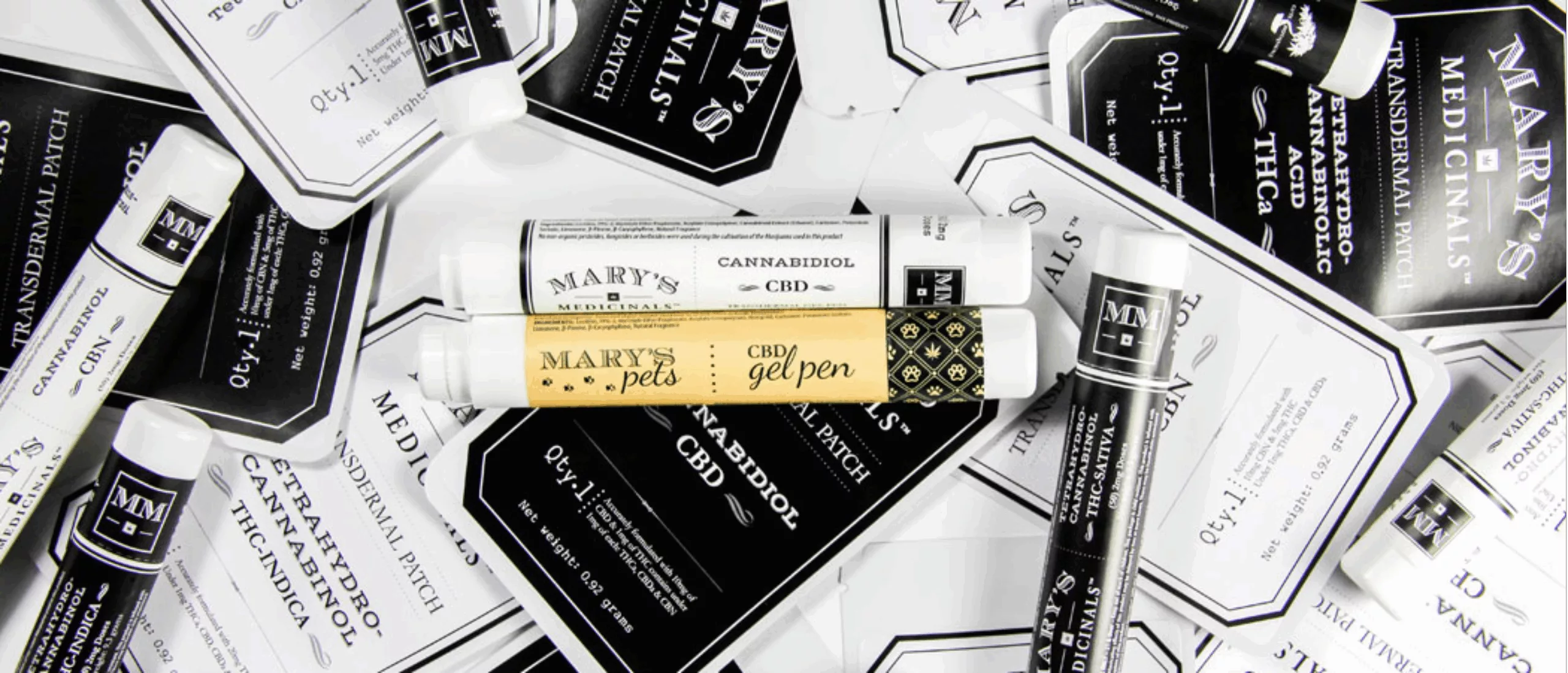
This positioning imagines products that are inspired by the visual codes of the pharmaceutical world. For example, the Floramedex brand has taken over the symbol of the pharmaceutical cross by mixing it with a cannabis leaf. The colours are generally sober and unadorned, we are not here to have fun but to heal. One could imagine that this branding style is limited to food supplements and CBD-based products, but cannabis in all its forms, from chocolate to dyeing to THC smoking grass, can be found there. Ritual drops, for example, use vials like those of former herbalists. This type of product gives a reassuring and medical image, sober and measured, to be taken to the nearest gram.

2 – Indie / holistic cannabis
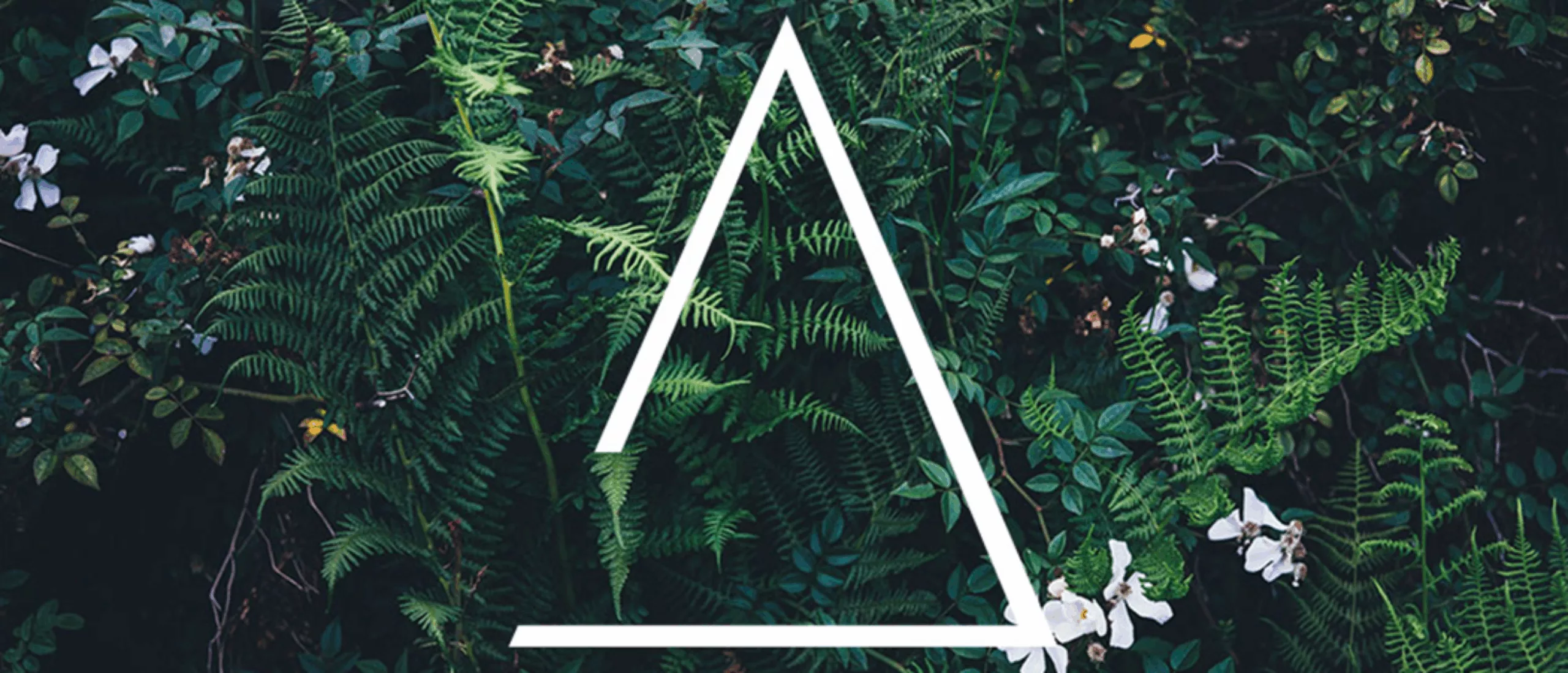
For nature lovers and adventurers. We will find here warm and natural colours, patterns, images of plants or holistic symbols, heralding inner journeys. This type of branding conveys a bohemian image, focused on a return to nature, for a complete sensory experience. It mainly targets women seeking inner well-being. Good Fortune joints, for example, are presented in packaging that recalls tarot cards, and use iridescent colours, and even pure gold, for a mineral and spatial look. The National Holistic Centre reminds us with its natural visuals that this place is a welcoming cocoon, close to people and nature.
Branding here acts as an omen that these joints and by-products will connect you to your mind, and make you live a strong psychic experience.

3 – Offbeat, fun cannabis
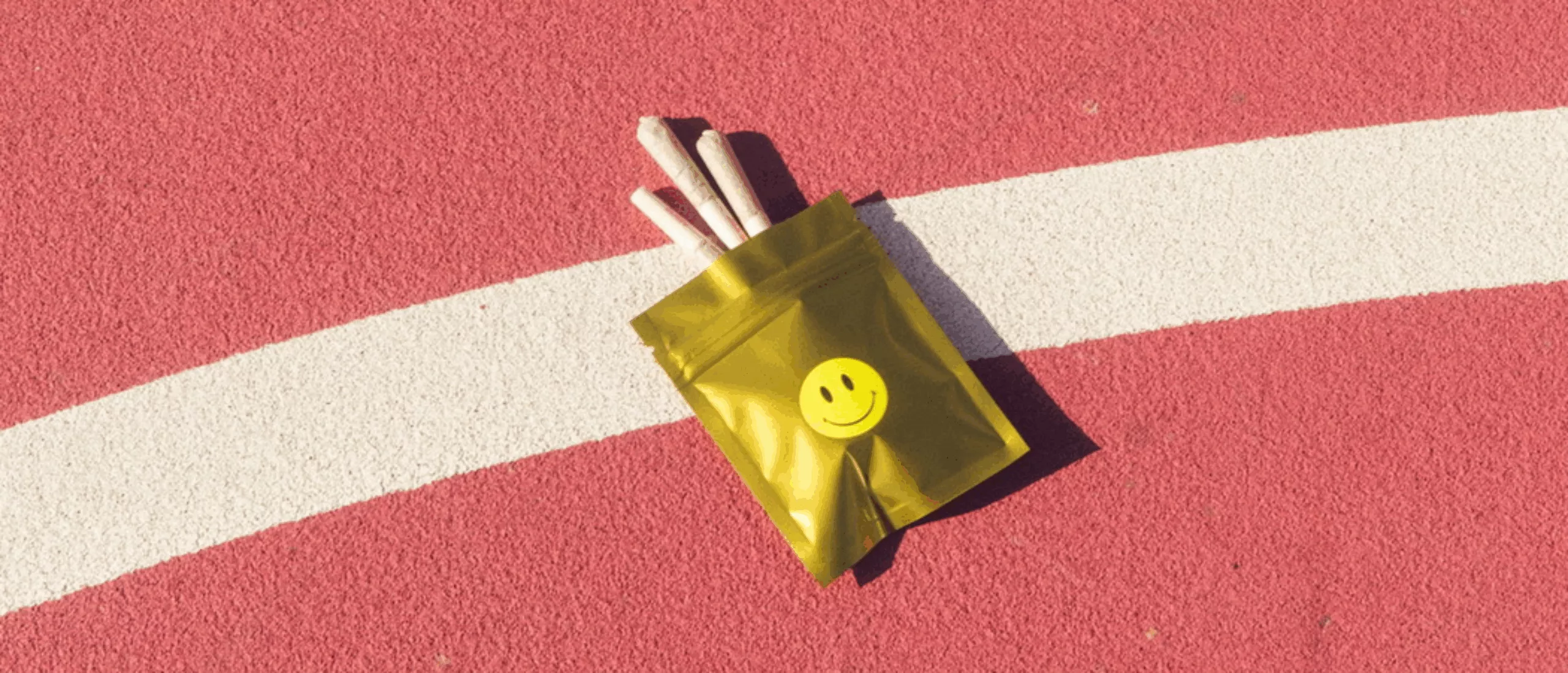
For cool people. Products with a young image, with bright colours, illustrations, offbeat photos, symbols… to have fun above all, without counting. These products are part of the heritage of the peace & love movement of the 1960s (like the Woodstock brand’s herb that uses the codes of the festival’s poster of the time) while adapting to our times. The Leafs by Snoop (Dogg) brand uses gliding images and sober packaging to experience “elevation” and invite you to travel “in the air”. A not really low cost trip since Snoop called on the Pentagram agency to brand its brand (Moreover, the agency seems to be well immersed in the product because it also produced the packaging for the Woodstock grass, and Harmony Extract). The Italians of Almamaria called on the illustrator Mateo Manenti to design their animal and offbeat packaging.
Without falling back into Rastafari codes, these brands offer fun cannabis without any headache.
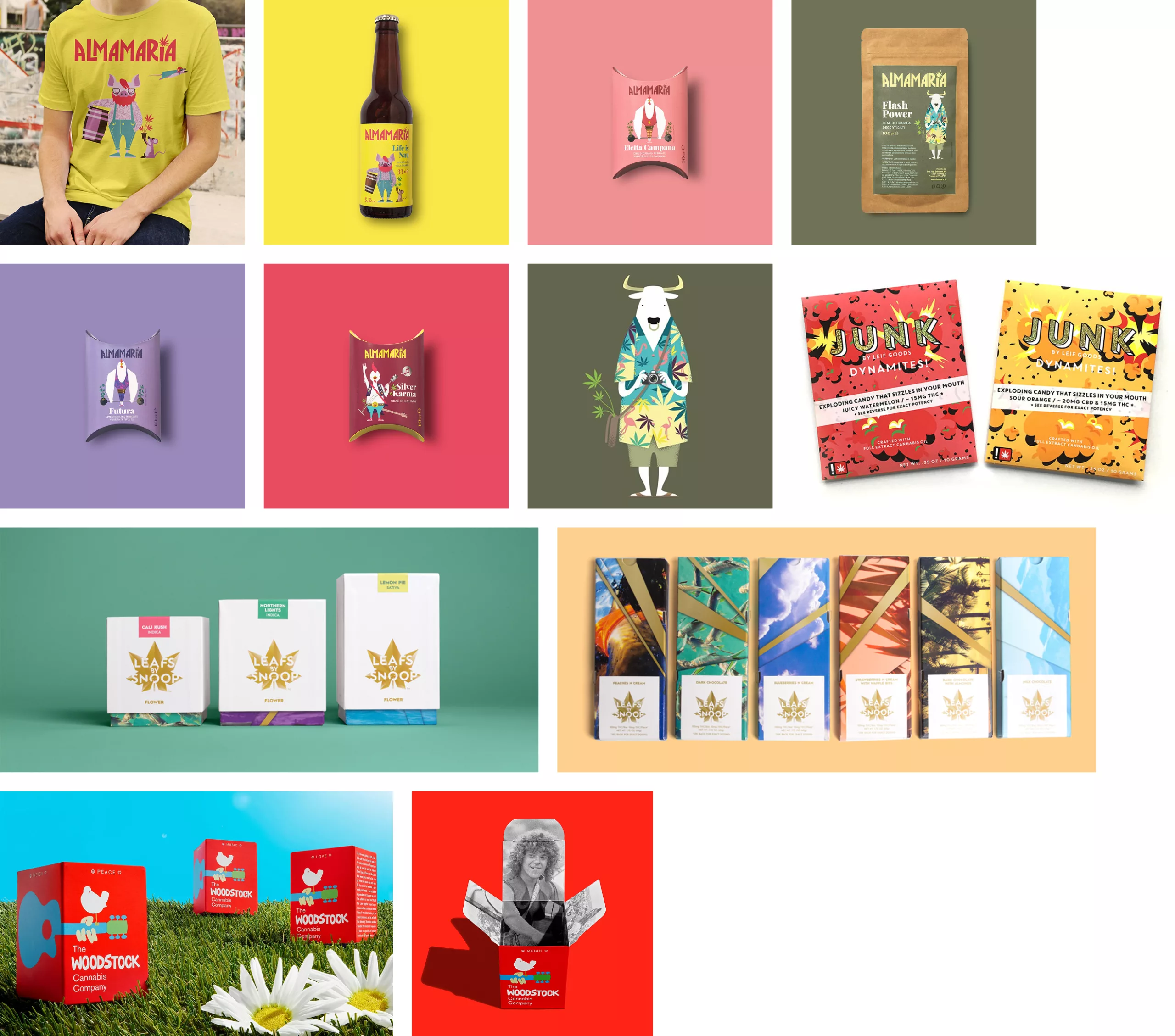
4 – Healthy cannabis

Do you like cannabis as a superfood? Here is the most striking example. Halfway between a pleasure, gourmet and healthy product, this kind of “healthy” cannabis positioning makes you want to treat yourself. A little like indie cannabis, there are illustrations and natural visuals. Here, the product is highlighted, as well as its ingredients. These are often organic brands, and the codes are the same as for this kind of products: eco-designed packaging, raw materials, plant visuals, soft colors… Would you like to have some more chocolate?
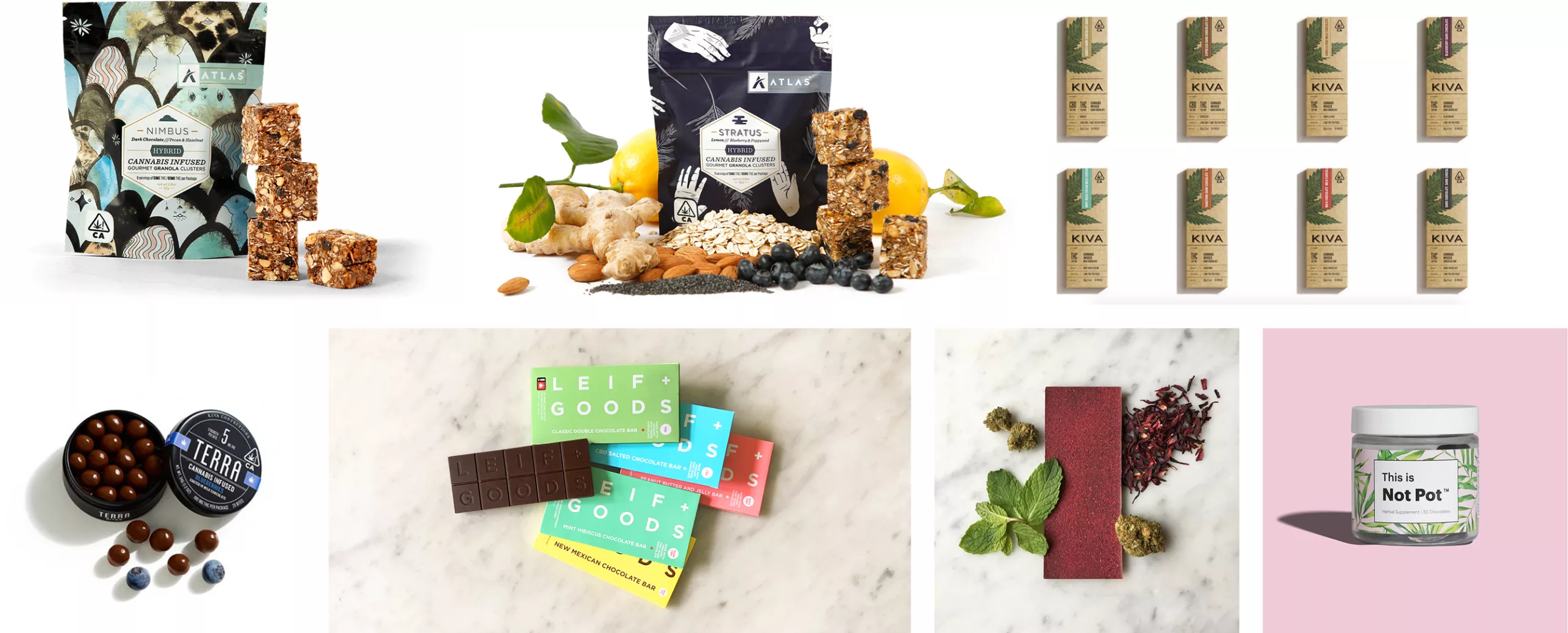
5 – High end cannabis

We could have just pushed the doors of the Bon Marché. Here, everything is only luxury, calm and voluptuousness. The chocolates are covered with gold, are wrapped by hand, and the slightest vial of oil is presented in a box worthy of a great whisky. Art, gilding and craftsmanship overlap to bring the ultimate in terms of cannabis derivatives. The ingredients are also highlighted as for “healthy” cannabis, but the staging is different. To whom it may chocolates are not just cannabis chocolates but “luxury artisanal cannabis chocolates”. Moreover, they are staged in artistic settings, alongside luxury objects and art. Lord Jones products are handcrafted in limited quantities for “Your Royal Highness”. The ultimate in craftsmanship serving cannabis. We would almost forget that we consume products with psychotic substances.
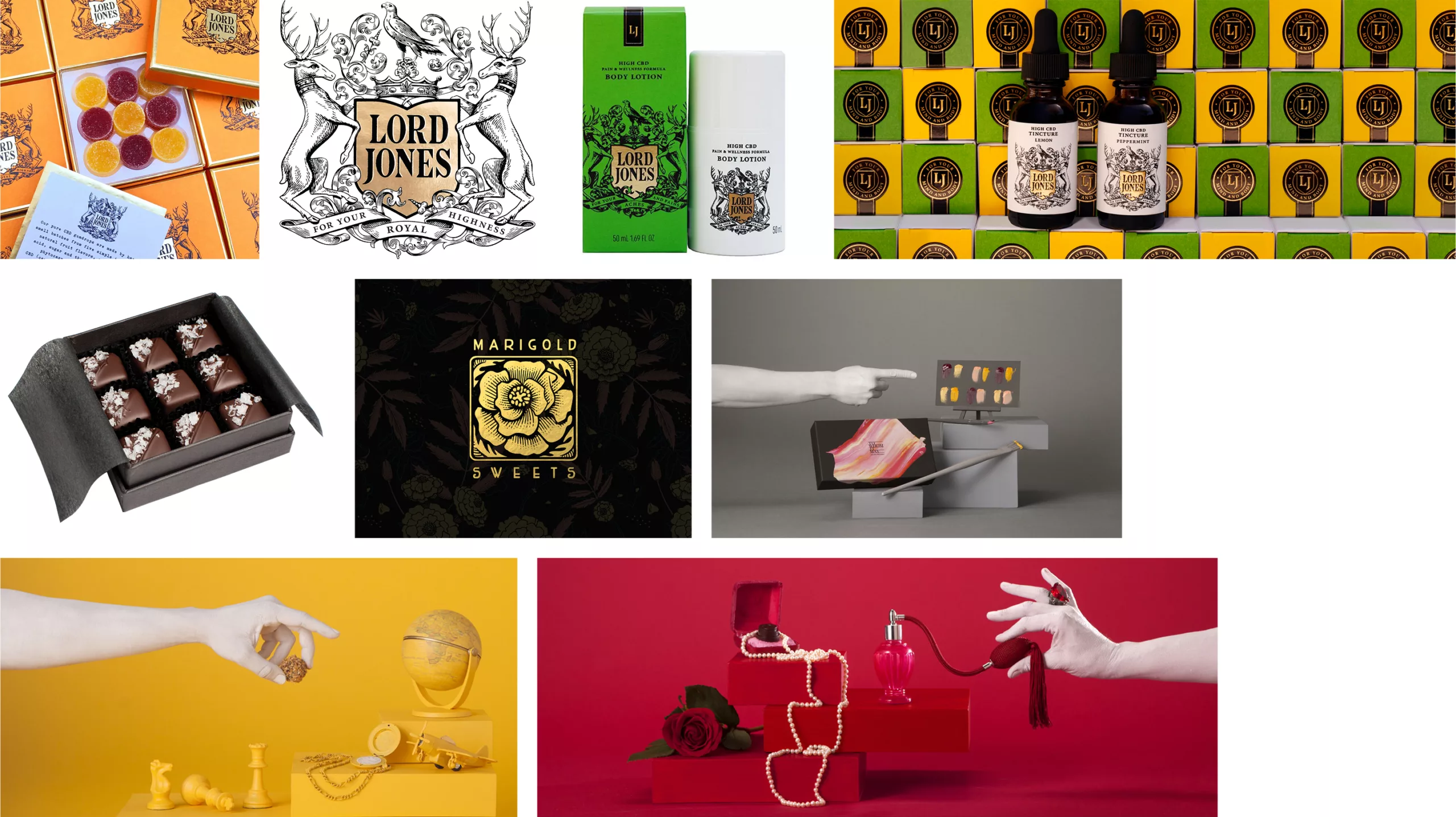
6 – Beauty cannabis
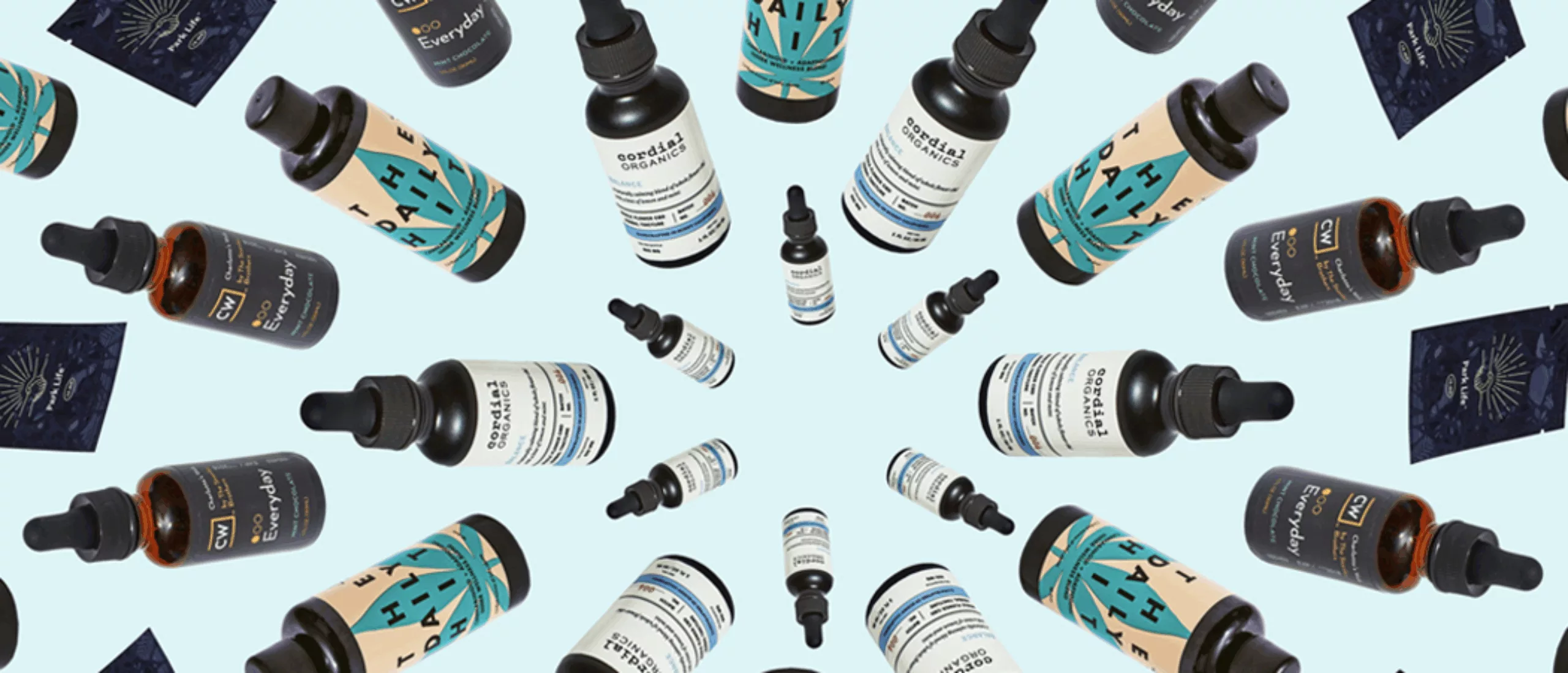
A little in the same vein as pharmaceutical cannabis, but mixed with healthy codes, here is cosmetic cannabis. Here, minimalism and health are required. These products are presented above all as high-end beauty products with active natural ingredients. We owe the branding of the Seven Point brand to Tortilleria, the same agency that created FloraMedex (see category 1). White on black, or fluorescent on white, the colours are in touches, effective and impactful. The shape of the packaging boxes is reminiscent of Leafs by Snoop. Again, the presence of cannabis herb is rarely found in the visuals, or treated graphically. On the presentation side, we would store these products on our sink rim, without even being pinched by the drug squad.

That’s it, that’s it, our tour de piste of the many faces of cannabis is over. Hoping that you have relaxed well, and that you are now looking forward to being able, perhaps one day, to make the branding of a (legal) CBD-based product!
Sources:
The history of hemp:
http://www.nuntisunya.com/histoire-chanvre/
http://hashmuseum.com/en/the-plant/medicinal-cannabis/history-of-medicinal-cannabis
http://hashmuseum.com/en/collection/medicinal-marihuana
https://www.ancient-origins.net/myths-legends-asia/magu-hemp-goddess-who-healed-ancient-asia-008709?nopaging=1
https://www.ancient-origins.net/history/cannabis-journey-through-ages-003084
http://hashmuseum.com/en/collection/making-hash
https://fr.wikipedia.org/wiki/Histoire_du_chanvre
http://almamaria.it/#/Home
https://www.ncbi.nlm.nih.gov/pmc/articles/PMC3358962/
Cannabis and Rastafari:
https://pointsadhsblog.wordpress.com/2015/06/11/the-use-of-marijuana-in-the-rastafari-religion/
Napoleon, Columbus and the hashish:
http://www.napoleon-empire.net/bonaparte-drogue.php
http://hashmuseum.com/fr/collection/colomb-et-le-cannabis
http://www.linternaute.com/histoire/jour/evenement/3/5/1/a/47983/christophe_colomb_debarque_en_jamaique.shtml
Hemp profits:
https://www.zamnesia.fr/blog-la-difference-entre-chanvre-et-cannabis-n1080
http://lemuseedufumeur.net/le-chanvre-pour-assainir-les-sols/
Cannabis and religion:
https://fr.wikipedia.org/wiki/Usage_spirituel_et_religieux_du_cannabis
A “tripping” website:
https://benicepaper.com/


